Thinking about a mulberry tree might bring up a familiar childhood rhyme, or perhaps a box of mulberry leaves in a shoebox with a silkworm collection, owned by a proud child. Or maybe your thoughts of this tree are less nostalgic and focus more on delicious mulberry fruit and inspired recipes.
In our mulberry tree how to grow and care guide, we’ll look at the different types of mulberry tree, the right conditions to care for your tree, how to propagate from a cutting, pests and diseases to be on the lookout for, a bush tucker section, and some frequently asked questions.
More...
Family: | Moraceae |
|---|---|
Genus: | Morus |
Common Names: | Mulberry tree, red mulberry, white mulberry |
Plant type: | Tree |
Size: | Up to 18 metres in height and 12 metres wide |
Sun: | Full or partial sunlight |
Soil type: | Moist and well-drained |
Soil pH: | Mildly acidic to neutral |
Flower colour: | Yellow green |
Maintenance level: | Low |
Poisonous to pets: | No |
Introducing the Mulberry Tree
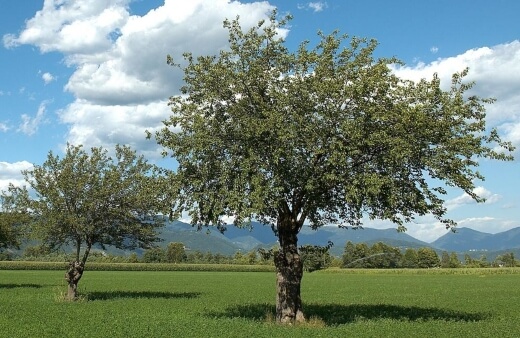
The mulberry tree has another delicious relation – it’s part of the fig tree family. You might be surprised to know there are more than 10 species of mulberry and we’ll go through the 5 most common types a bit later in the article.
These trees like warm and subtropical climate – maybe similar to the dream holiday for those of us who sit behind a desk most of our working days.
The tree goes way back to the ancient civilizations, especially in ancient Greece where the mulberry fruit was offered to the goddess of wisdom.
Mulberry Tree's Natural Habitat
In the wild, you would find a mulberry tree happily living in a wet forest or near a water source. It also needs lots of sunlight and by the same token, actually offers plenty of shade.
Both the red and white mulberry tree have berries that you would easily mistake for blackberries and the white mulberry in particular spreads like wildfire.
Here’s a little tip – both the leaves and the not yet ripe mulberry fruit contain latex. It’s slightly toxic so best to wait for ripe fruit.
Mulberry Tree Species
There are five species of mulberry trees. They are:
White mulberry tree |  |
Red mulberry tree |  |
Black mulberry tree | 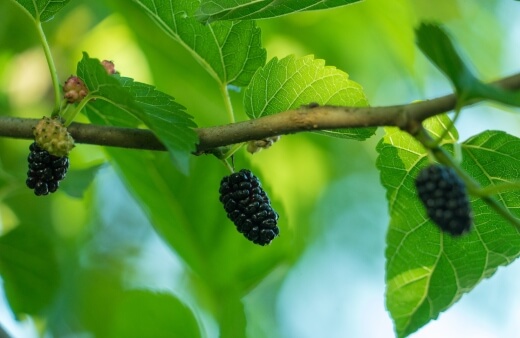 |
Korean mulberry tree | 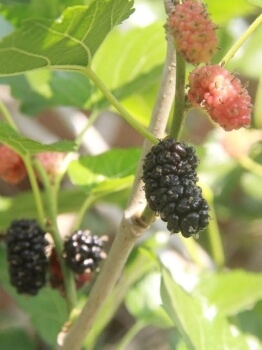 Source: raintreenursery.com |
Texas mulberry tree | 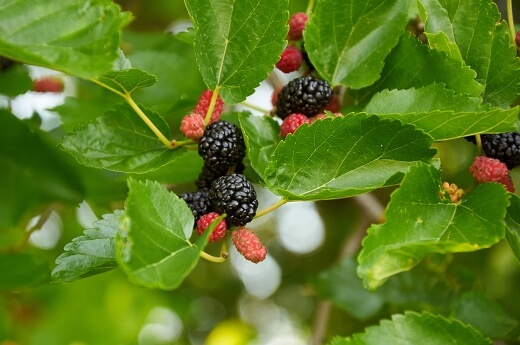 Source: sptreeservice.com |
White mulberry tree (Morus alba)

This species is the most common and found in North America. Its fruit looks like blackberries, starting off white and then turning dark purple.
Red mulberry tree (Morus rubra)

Morus rubra grows wild in Canada and the USA. The leaves are double the length of the white mulberry tree leaves.
Black mulberry tree (Morus nigra)

Black mulberry tree grows to about 12 metres in height and has large, dark purple berries. It is native to Asia.
Korean mulberry tree (Morus australis)

Source: raintreenursery.com
This species is small and its fruit varies in colour from white to red.
Texas mulberry tree (Morus celtidifolia)

Source: sptreeservice.com
Texas mulberry tree look more like a shrub and are short. The fruit colours are red, purple and black.
How to Grow Mulberry Trees
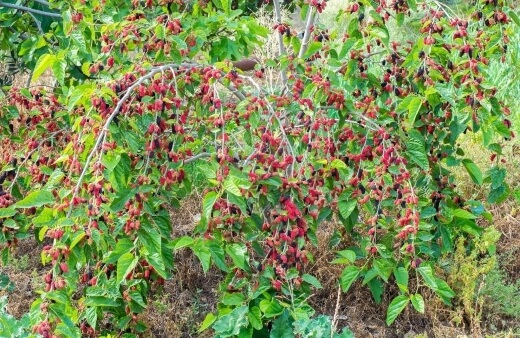
When thinking about whether you want to add a mulberry tree to your garden, you need to consider two things. One, is which cultivar is going to be best for the region that you live in climate wise.
The other consideration is choosing the right spot for the tree. Their roots are strong and they grow fast – so not a tree that you want to plant too close to your home or other structure that could get damaged by the very eager mulberry tree.
You also need to think about how high your mulberry tree might grow so you can make sure there isn’t anything in the way of its growth.
Propagating Mulberry Tree
Propagation of your own mulberry tree is fairly simple using a cutting. You want to do this in spring to take a cutting with some new growth but it mustn’t be too soft or two green. A cutting about 20cm in length is ideal.
Once you have your cutting, dip the end in some rooting hormone and plant in a pot with some potting soil. Give your cutting lots of water. You’re then going to place your pot or pots if you’re propagating a few cuttings, into a plastic bag and fasten it.
The pots should be placed somewhere shaded. Be sure to check the soil so it doesn’t dry out. After about a month, your cuttings should have roots.
Now you can take off the plastic bag and let the cutting continue to grow in the pot until autumn. After that, you can then transplant into the garden.
Mulberry Care Guide
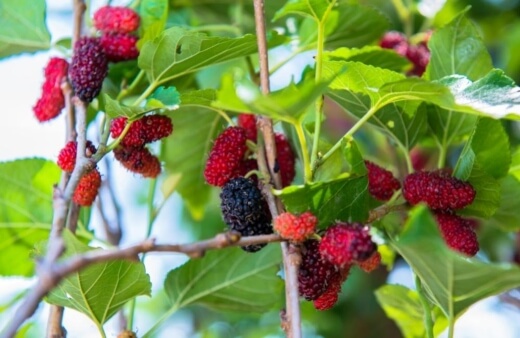
Sunlight Preference
A mulberry tree is equally happy with full sun or part shade, giving you options of where to plant it. If you are wanting to maximise fruit from your tree, then aim for more sunlight.
Best Soil for Mulberry Tree
Choosing the right soil for your mulberry tree is fairly simple – they will grow in clay, loam or sandy soil. What’s more important is making sure that your soil is well-draining. pH is also not a major issue – you can aim for neutral to slightly acidic.
Watering Schedule
Making sure your mulberry tree gets enough water during the first year after planting will set it up for future health and well-being. In that first year, water often and generously.
When the mulberry tree is mature, they can handle drought and dry weather with ease.
Temperature and Climate
Mulberry trees are good with the cold but they will bless you with an abundance of fruit if they are growing in an area that has a temperature of between 20-30°C.
What Fertiliser to Use
Your mulberry tree doesn’t need fertiliser often – once a year is plenty at the end of winter. A 10-10-10 formulation is ideal.
Pruning Mulberry Tree
True to its happy go lucky nature, you don’t really need to bother pruning a mulberry tree. If you see any shoots that are damaged, you can cut these away during the winter. This helps the tree not to lose sap.
Mulberry Tree Bush Tucker Guide
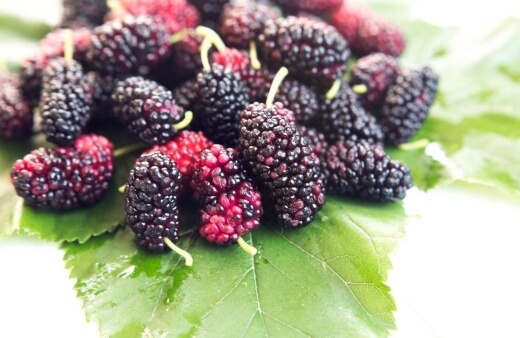
It takes about 10 years for a mulberry tree to produce fruit. The fruit is quite power packed with vitamins like vitamin C, A, E and K. It’s also mineral rich in things like potassium, iron and magnesium.
If you’re looking to boost your dietary fibre, stock up and fill up on mulberry tree fruit. The fruit is sweet but the taste isn’t always consistent.
So what can you do with the fruit or how is it used? It can definitely be eaten raw, but is also popular to make jam and in baked goods. It’s used to make wine, juice and tea too. You can even dry the fruit for later consumption.
The mulberry tree fruit is known for having loads of health benefits. It’s great for managing blood sugar and cholesterol, helps your heart and circulation, and has brain and immunity boosting properties too.
Plenty of reasons to add mulberry fruit to your diet and to look into having your very own mulberry tree so you can enjoy all these benefits.
If you want to save your mulberries for later, they are ideal for freezing. After defrosting they become paste like so pop them in a smoothie for a power packed meal on the go.
Mulberries are high in protein so you’ll feel satisfied. Mulberries can also be dried and kept in a sealed container.
Australia has such delightful bush tucker. We have plenty of valuable information about how to gather and use native fruits and trees. Have a look at our collection of bush tucker articles.
Pests and Diseases that May Affect Your Mulberry Tree
Unfortunately warmer weather does tend to mean more challenges in terms of pests and disease. Any tree that produces delicious fruit (or any fruit for that matter) is bound to have some pests to compete with.
Scales and Mealybugs
The mulberry tree could be affected by critters such as scale and mealybugs. Neem oil is a wonderful and natural insect repellent and plant protector.
You only really need to worry about the younger trees and help them along. The older trees aren’t really fazed by these bugs and any damage would be minimal.
Bacterial and Fungal Diseases
With regards to disease, bacterial and fungal diseases might appear, like leaf spot. Again, it doesn’t mean doom for your tree if this does happen.
You can remove the parts of your tree that are infected and manage with an organic fungicide for example.
Sign up for our newsletter for every day gardening tips and advice.
Mulberry Tree Frequently Asked Questions
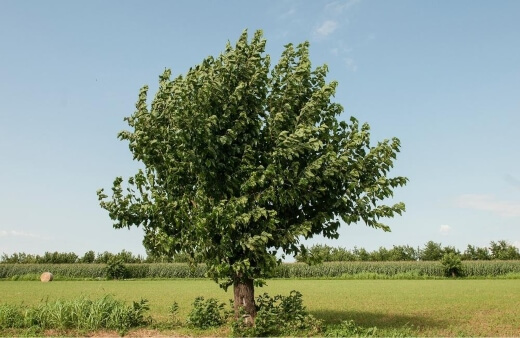
I’ve heard that a mulberry tree can be dioecious. What does that mean?
Dioecious plants have different male and female plants – in other words, both are not found on the same plant. The flowers are actually designed in such a way to be easily pollinated by the wind. Some mulberry trees don’t even need to be pollinated to produce fruit.
Why do silkworms like mulberry tree leaves?
Silkworms like the white mulberry tree leaves in particular as a food source. The caterpillars hide themselves in silk pods and these are used worldwide. White mulberry leaves have been used to make silk for thousands of years in China.
Mulberries and the silk industry go hand in hand. The rise and growth of the silk industry in many ways is what has helped the lovely mulberry tree to make its way across the world.
Does the mulberry tree have any medicinal qualities?
In ancient times, the Romans would use the leaves of the white mulberry tree to treat mouth and lung disease. In America, mulberry trees were used as a laxative and to treat dysentery.
How is the fruit used as colouring?
The mulberry tree produces colour pigments of blue, orange, red, purple and black. This is used to colour food and also fabrics.
Can you use the wood of the mulberry tree for anything?
The branches of the tree have been used to make baskets and the tree wood is used to make barrels.
How long can a mulberry tree live?
The red mulberry tree can live to a ripe old age of 75 years. The black mulberry lives the longest though, sometimes a few hundred years.
Interested in growing more Australian native plants? Check out our comprehensive guide to growing native mulberry and Atherton raspberry for more info.
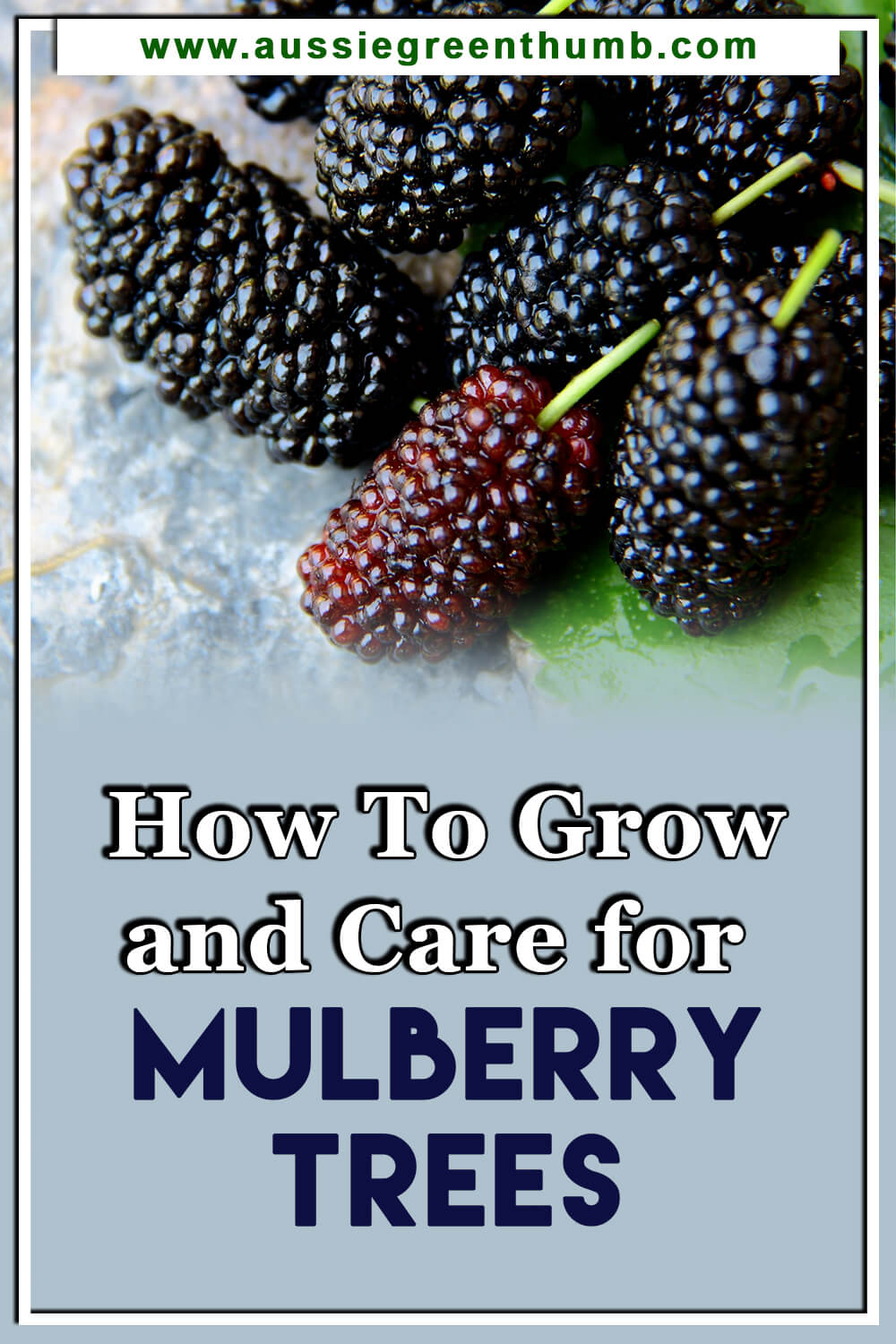
Wrapping Up Our Mulberry Tree Growing Guide
A mulberry tree in your garden can become the place where you picnic with family, under the shady branches. It can be a source of delicious fruit (complete with health benefits), and something you admire as it grows and adds character to your garden.
Maybe your mulberry tree is the spot you retreat to with a book and a cup of tea, or the place you gather friends to take a group photograph.
Since a mulberry tree is so adaptable and easy to grow, it’s become a popular choice (just space it the right distance from anything that the eager roots might overtake).
We’re giving the beautiful mulberry tree (with a very rich history), our green thumbs up.
Published on July 17, 2023 by Nathan Schwartz
Last Updated on February 22, 2024




